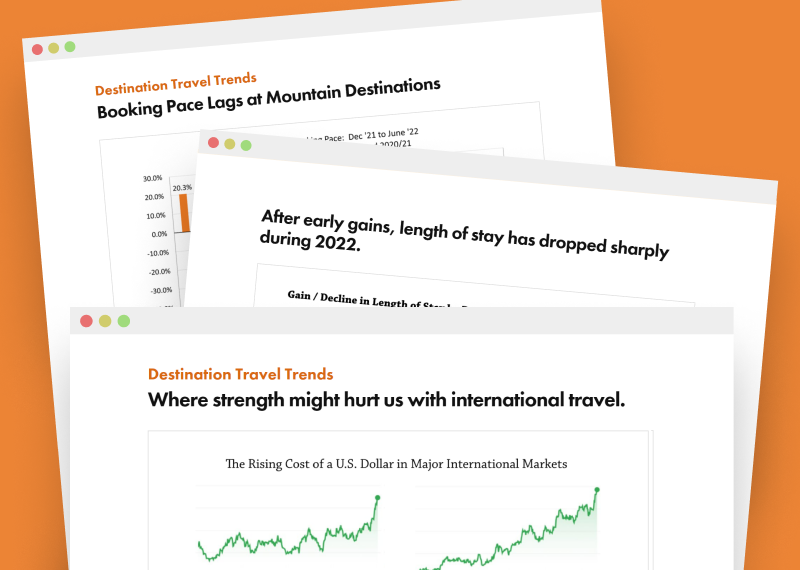

 Katie Barnes
Katie Barnes
Light snowfall and limited terrain openings have had minimal, if any, impact to the start of the ski and snowboard season—and the all-important holiday season looming ahead. As of Nov. 30, aggregated occupancy, rates, and revenue for the coming winter are not only comparing favorably to last season but even more impressively, against two years ago at this time. The latest data compiled from the contributions of 290 western lodging properties released by DestiMetrics,* the Business Intelligence division of Inntopia, reveals an optimistic trajectory for the coming winter. So, while disappointing snow conditions could pose a challenge later in the season, the DestiMetrics data suggests that skiers and riders are currently shrugging off concerns about the latest COVID-19 variant, rising daily rates, and softening in some economic indicators to relish a hopefully more typical on-slope experience after the uncertainty and challenges of last winter.
No sign of Scrooge this year
Stats for the month of November were, as expected, well ahead of last November when lodging properties were working to lure visitors prior to the vaccine rollout. Actual occupancy was up 10.5 percent in a year-over-year comparison while the Average Daily Rate (ADR) was up a comfortable 9.3 percent. The combination delivered a healthy 20.8 percent increase in revenue compared to November 2020. However, when contrasted to two years ago, occupancy for the month was down 4.2 percent but ADR was up a robust 35.7 percent and that impressive growth in rates in the past two years resulted in a 30 percent increase in November revenues.
While November occupancy paced down compared to two years ago, the full winter is currently exhibiting robust strength versus all comparative years. On-the-books occupancy from November through April is up a formidable 73.8 percent compared to last year at this time with gains in all six months. ADR for the winter is up an aggregated 29.8 percent and when coupled with the dramatically higher increase in occupancy, is providing a remarkable 125.5 percent increase in revenues. And when compared to the pre-pandemic metrics two years ago at this time, the results are noteworthy. On-the-books occupancy as of Nov. 30 is currently up 11 percent while the ADR for the winter is up 28.6 percent. Again, the continued strength in both categories is providing a 42.8 percent increase in revenues compared to two years ago at this time.
“An extremely strong base of early bookings coupled with Christmas Day and New Year’s Day falling on a Saturday really helped boost the holiday outlook for this year,” observed Tom Foley, senior vice president for Business Process and Analytics for Inntopia. “And while everyone is feeling quite jolly about December, the good news at this point is that despite marginal snowfall in many regions, the months of January through April are all currently overperforming the records set in previous seasons,” he added.
Economic indicators
In contrast to October, the Dow Jones Industrial Average (DJIA) lost a significant 3.7 percent during November as investors retreated from the market in the face of rising inflation and potential actions by the Federal Reserve to react to address and mitigate inflation trends. Also providing some drag on the Index was a mediocre Black Friday with in-store retail sales down 28.3 percent from pre-pandemic levels and a lackluster Cyber Monday—down 1.4 percent from last year. The Consumer Confidence Index (CCI) dipped down 1.9 percent from October and marks the fourth decline in the past five months.
The national Unemployment Rate declined for the fourth consecutive month during November—dropping 0.4 percentage points to 4.2 percent and its lowest level since the onset of the pandemic. However, only 210,00 new jobs opened during the month, well below the 575,000 new positions that analysts anticipated. This marks the third time in the past four months that job targets were below expectations as workers remain detached from traditional jobs. The travel and leisure sectors continue to be dramatically understaffed despite aggressive recruiting efforts by employers. More than 1.45 million jobs from February 2020 remain unfilled.
“Despite low job creation, there is some positive economic news,” offered Foley. “A net increase in workforce participation and an increase in wages is helping to offset the high inflation rate.”
Keeping an eye on
-Booking lead times have been getting consistently longer compared to pre-pandemic patterns as consumers focused their attention on the holiday season, particularly Christmas arrivals. As travel plans are now moving toward mid-season, the booking lead- time is shortening but remains longer than pre-pandemic.
-Weather and snowfall for the La Nina winter pattern has raised concerns but might be premature because although many western and central mountain regions are struggling, other regions—notably the Pacific Northwest and Northeast—are faring well compared to the last two winters.
“In a clearly mixed bag of indicators, slowing economic conditions are accompanied by record room rates and high occupancy levels for the weeks immediately surrounding the Christmas holidays,” Foley reported. “But definitely, the late-November news of the Omicron variant is definitely showing up in the booking pace data. However, the foundation laid by significant winter bookings as early as last June, have ensured that the next four weeks—and possibly beyond—are a lock under most circumstances. But the issue of snow literally hangs in the air and is fueling some angst,” he continued.
In summing up the monthly assessment, Foley acknowledged that “more than a few slow snowfall starts to a winter season become good to excellent seasons, but that snowfall ‘wildcard’ is an issue the industry is hoping not to contend with when there are so many other uncertainties this season,” he concluded.
###
*DestiMetrics, part of the Business Intelligence platform for Stowe-based Inntopia, tracks lodging performance in resort destinations. They compile forward-looking reservation data each month and provide individualized and aggregated results to subscribers at participating resorts. Data for western resorts is derived from a sample of approximately 290 property management companies in 18 mountain destination communities, representing approximately 30,000 rooms across Colorado, Utah, California, Nevada, Wyoming, Montana, and Idaho and may not reflect the entire mountain destination travel industry. Results may vary significantly among/between resorts and participating properties.
Have a question? Just ask.

Tyler Maynard
SVP of Business Development
Ski / Golf / Destination Research
Schedule a Call with Tyler→

Doug Kellogg
Director of Business Development
Hospitality / Attractions
Schedule a Call with Doug→
If you're a current Inntopia customer, contact support directly for the quickest response →
Request Demo
A member of our team will get back to you ASAP to schedule a convenient time.



